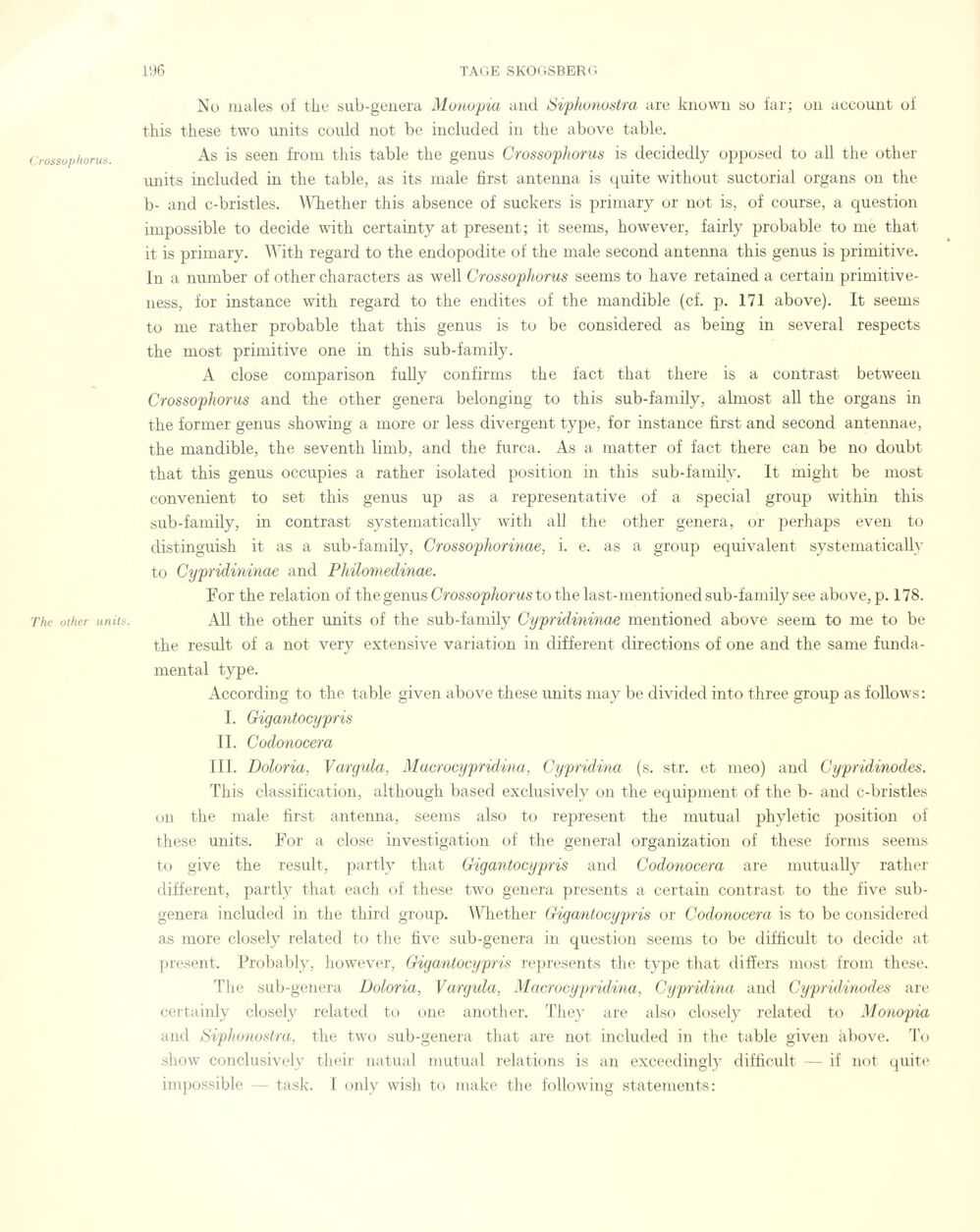
Full resolution (JPEG) - On this page / på denna sida - Sidor ...

<< prev. page << föreg. sida << >> nästa sida >> next page >>
Below is the raw OCR text
from the above scanned image.
Do you see an error? Proofread the page now!
Här nedan syns maskintolkade texten från faksimilbilden ovan.
Ser du något fel? Korrekturläs sidan nu!
This page has never been proofread. / Denna sida har aldrig korrekturlästs.
Crossophorus.
The other units.
No males of tlie sub-genera Monopia and Siphonostra are known so far; on account of
this these two units coidd not be included in the above table.
As is seen from this table the genus Crossophorus is decidedly opposed to all the other
units included in the table, as its male first antenna is quite without suctorial organs on the
b- and c-bristles. Whether this absence of suckers is primary or not is, of course, a question
impossible to decide with certainty at present; it seems, however, fairly probable to me that
it is primary. With regard to the endopodite of the male second antenna this genus is primitive.
In a number of other characters as well Crossophorus seems to have retained a certain
primitive-ness, for instance with regard to the endites of the mandible (cf. p. 171 above). It seems
to me rather probable that this genus is to be considered as being in several respects
the most primitive one in this sub-family.
A close comparison fully confirms the faet that there is a contrast between
Crossophorus and the other genera belonging to this sub-family, almost all the organs in
the former genus showing a more or less divergent type, for instance first and second antennae,
the mandible, the seventh limb, and the furca. As a matter of fact there can be no doubt
that this genus occupies a rather isolated position in this sub-family. It might be most
convenient to set this genus up as a representative of a special group within this
sub-family, in contrast systematically with all the other genera, or perhaps even to
distinguish it as a sub-family, Crossophorinae, i. e. as a group équivalent systematically
to Cypridininae and Philomedinae.
For the relation of the genus Crossophorus to the last-mentioned sub-family see above, p. 178.
All the other units of the sub-family Cypridininae mentioned above seem to me to be
the result of a not very extensive variation in different directions of one and the same
fundamental type.
According to the table given above these units may be divided into three group as follows:
I. Gigantocypris
II. Codonocera
III. Doloria, Vargula, Macrocypridina, Cypridina (s. str. et meo) and Cypridinodes.
This classification, although based exelusively on the equipment of the b- and c-bristles
on the male first antenna, seems also to represent the mutual phyletic position of
these units. For a close investigation of the general organization of these forms seems
to give the result, partly that Gigantocypris and Codonocera are mutually rather
different, partly that each of these two genera presents a certain contrast to the five
subgenera included in the third group. Whether Gigantocypris or Codonocera is to be considered
as more closely related to the five. sub-genera in question seems to be difficult to decide at
present. Probably, however, Gigantocypris represents the type that differs most from these.
The sub-genera Doloria, Vargula, Macrocypridina, Cypridina and Cypridinodes are
certainly closely related to one another. They are also closely related to Monopia
and Siphonostra, the two sub-genera that are not included in the table given above. To
show conclusivcly their natual mutual relations is an exceedingly difficult — if not quite
impossible — task. I only wish to make the following statements:
<< prev. page << föreg. sida << >> nästa sida >> next page >>